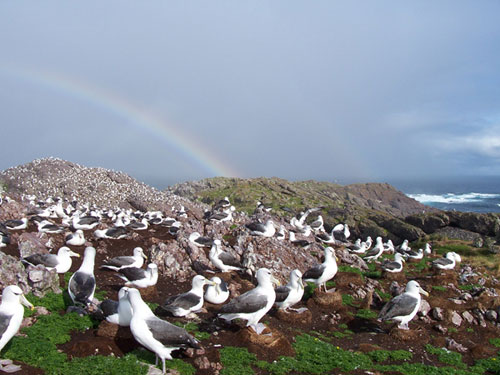Two recent publications appearing in the journal Marine Ecology Progress Series give new information on the at-sea behaviour and distribution of five species of albatrosses in the southern hemisphere.
Rachael Alderman and colleagues, based in Tasmania, Australia, studied the post-fledging survival and dispersal of Shy Albatrosses Thalassarche cauta by deploying 48 satellite transmitters on fledglings from each of the three Tasmanian populations over four separate seasons.
Population differences in the at-sea distribution were observed with the northern Albatross Island population foraging exclusively in southern Australian shelf waters to the west of the breeding colony. In contrast, birds from the other two more southerly colonies showed a greater tendency to traverse the high seas and to forage farther to the west. These differences in spatial distribution mean populations have different exposures to fisheries and consequent risks of bycatch.

Elizabeth K. Mackley and colleagues at the British Antarctic Survey and the University of Glasgow in the UK also deployed devices on albatrosses, this time combination geolocator-immersion loggers on Wandering Diomedea exulans, Black-browed Thalassarche melanophris, Grey-headed T. chrysostoma and Light-mantled Sooty Phoebetria palpebrata Albatrosses at a South Atlantic colony.
Differences in behaviour among the four species during the breeding season were maintained during the non-breeding period, suggesting a high degree of foraging niche specialisation. Wandering Albatrosses exhibited longer flight bouts, and spent more time on the water during daylight than did any of the smaller species. Light-mantled Sooty Albatrosses were the most active nocturnally.
References:
R. Alderman, R. Gales, A.J. Hobday & S.G. Candy 2010. Post-fledging survival and dispersal of Shy Albatross from three breeding colonies in Tasmania. Marine Ecology Progress Series 405: 271-285. http://www.int-res.com/abstracts/meps/v405/p271-285/.
Elizabeth K. Mackley, Richard A. Phillips, Janet R. D. Silk, Ewan D. Wakefield, Vsevolod Afanasyev, James W. Fox & Robert W. Furness 2010. Free as a bird? Activity patterns of albatrosses during the non-breeding period. Marine Ecology Progress Series 406: 291-303. http://www.int-res.com/abstracts/meps/v406/p291-303/.
John Cooper, ACAP Information Officer, 10 July 2010

 English
English  Français
Français  Español
Español